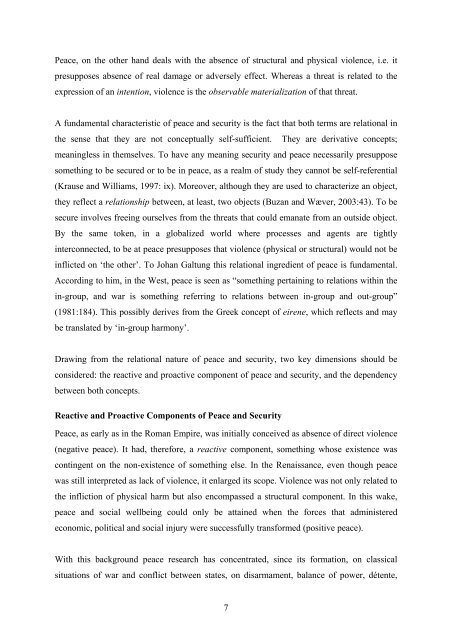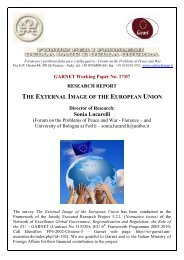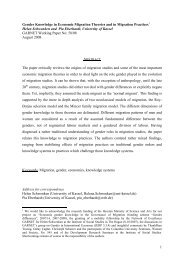GARNET Working Paper No. 13/07
GARNET Working Paper No. 13/07
GARNET Working Paper No. 13/07
Create successful ePaper yourself
Turn your PDF publications into a flip-book with our unique Google optimized e-Paper software.
Peace, on the other hand deals with the absence of structural and physical violence, i.e. it<br />
presupposes absence of real damage or adversely effect. Whereas a threat is related to the<br />
expression of an intention, violence is the observable materialization of that threat.<br />
A fundamental characteristic of peace and security is the fact that both terms are relational in<br />
the sense that they are not conceptually self-sufficient. They are derivative concepts;<br />
meaningless in themselves. To have any meaning security and peace necessarily presuppose<br />
something to be secured or to be in peace, as a realm of study they cannot be self-referential<br />
(Krause and Williams, 1997: ix). Moreover, although they are used to characterize an object,<br />
they reflect a relationship between, at least, two objects (Buzan and Wæver, 2003:43). To be<br />
secure involves freeing ourselves from the threats that could emanate from an outside object.<br />
By the same token, in a globalized world where processes and agents are tightly<br />
interconnected, to be at peace presupposes that violence (physical or structural) would not be<br />
inflicted on ‘the other’. To Johan Galtung this relational ingredient of peace is fundamental.<br />
According to him, in the West, peace is seen as “something pertaining to relations within the<br />
in-group, and war is something referring to relations between in-group and out-group”<br />
(1981:184). This possibly derives from the Greek concept of eirene, which reflects and may<br />
be translated by ‘in-group harmony’.<br />
Drawing from the relational nature of peace and security, two key dimensions should be<br />
considered: the reactive and proactive component of peace and security, and the dependency<br />
between both concepts.<br />
Reactive and Proactive Components of Peace and Security<br />
Peace, as early as in the Roman Empire, was initially conceived as absence of direct violence<br />
(negative peace). It had, therefore, a reactive component, something whose existence was<br />
contingent on the non-existence of something else. In the Renaissance, even though peace<br />
was still interpreted as lack of violence, it enlarged its scope. Violence was not only related to<br />
the infliction of physical harm but also encompassed a structural component. In this wake,<br />
peace and social wellbeing could only be attained when the forces that administered<br />
economic, political and social injury were successfully transformed (positive peace).<br />
With this background peace research has concentrated, since its formation, on classical<br />
situations of war and conflict between states, on disarmament, balance of power, détente,<br />
7





